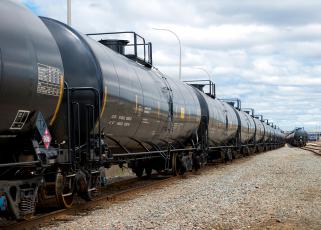A recent morning news story I came across suggested that fuel production at U.S. refineries might be lagging behind demand and driving up gasoline prices at the pump (spoiler: false). Of course, politics were also mentioned as a driving factor, and I felt it would be a good time to post a refresh on what actually makes up the prices we see at our local gas stations. The truth is never as newsworthy as the pundit class would hope.
What’s reflected in the price of a gallon of gas?
Quite a bit, but the raw materials (in this case crude oil) account for the biggest share of the final price consumers pay. The U.S. Energy Information Administration breaks down the price of a gallon of gasoline into component costs. As seen in the graph below, crude oil clearly represents the largest percentage of final fuel costs, while the refining sector contribution has often been the smallest and has been shrinking over time. Costs attributable to policy (federal, state, and local taxes, etc.) and marketing and distribution (pipeline transportation and fuel truck delivery) have been increasing, and in a number of states, fuel taxes went up again on July 1st of this year.

Are U.S. refineries keeping pace?
Yes. Refineries are not the story when it comes to gasoline prices. U.S. refinery crude inputs averaged 16.3 million barrels per day for the week ending June 11, 2021, the highest level since February 2020. Compared to May 2021, U.S. refineries are processing one million more barrels of crude oil daily.
From all this crude, American refineries and blenders produced:
- 9.9 million barrels of gasoline daily—well in excess of the 9.1 million barrels consumed by American drivers. Gasoline stocks are up, and exports have returned to pre-pandemic levels.
- 5 million barrels per day of distillate, up from the 4.5-4.6 million barrels per day typical of the past several months. With exports up and U.S. distillate demand averaging about 4 million barrels per day, the supply side for distillate, like gasoline, is bigger.
Bottom line: The data makes it clear that U.S. refineries are not struggling to keep pace. In fact, we have more than enough gasoline and diesel to satisfy the American market.
If not a supply story, what’s driving prices and shortages at the pump?
On the first point, crude oil, as we covered above, is the #1 contributor to prices paid at the pump. When crude prices are down, that that tends to have an impact on prices at the pump. The converse is true as well (see below). Crude oil prices declined in 2020 as pandemic related lockdowns dramatically reduced how much we all drove, and as a result, demand for crude oil and transportation fuels. But more recently, as economies have reopened, demand for transportation fuels has increased and crude oil prices have moved higher.

As both images clearly illustrate, the effect of marketing and distribution on final retail costs has been increasing. Within this space there are some challenges, one of which the National Association of Convenience Stores summed in a recent blog titled There’s Gasoline Aplenty But a Paucity of Tanker Drivers.
Plainly put, there’s a shrinking workforce of tank truck drivers, a problem that got worse over the course of COVID-19 shutdowns. Now that economies are opening back up and fuel consumption is returning to pre-pandemic levels, and surging around the July 4 holiday, there aren’t enough people to deliver gasoline and diesel to the stations where it’s needed.
So, the challenge is not that there isn’t enough gasoline and diesel, it’s that the energy distribution system has some kinks making it hard to get fuel to retailers. Addressing those challenges is not as simple as just recruiting new drivers to the fleet. The jobs are great, pay well, and provide a lot of flexibility, but they require extensive training and qualification. It takes time to rebuild that workforce. Consider recommending it to people you know who are on the job hunt or looking to make a change.
Moral of the story
The price at the pump is always a function of the price of crude oil, and the refining sector does not set crude oil prices. Our focus is always on supplying the U.S. and global markets with critical refined products as efficiently as possible. U.S. refinery crude inputs have remained at higher levels over the last several weeks as have U.S. refinery utilization rates and that tells the story.


